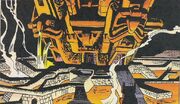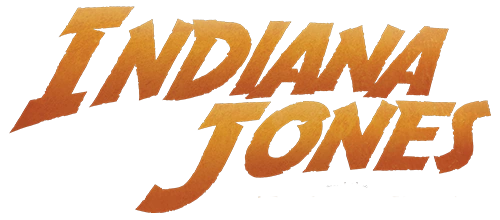Atlantis was a lost island civilization, about 7.5 miles southeast of the present-day island of Thera in the Aegean Sea. It possessed a great technology and civilization but eventually sank beneath the waves. The people of Atlantis were sometimes referred to as Atlanteans.
History[]
Origins[]
Bjorn Heimdall believed that spacemen visited Earth and built colonies, like Atlantis.[2]
However, according to high priest Nur-Ab-Sal's revelation things were a bit different. The Atlanteans were approached by mysterious Alien horned beings who taught them technology and gave them the secret of the Orichalcum before vanishing as suddenly as they came. This technology included automatization and the powering of metallic robots that performed the work of slaves.[1] Atlantean soil also produced special crystals that possessed special powers. Filled with pride, the Atlanteans, conquered the "island kingdoms" of the Aegean and the known world. Atlantis had at least two colonies in the Aegean, such as the Greater at Knossos, Crete and the Lesser on Thera. Atlanteans included the Shintay who believed in a cult of death. For this they were banished from the city shortly before the cataclysm taking with them the technology of crystals.[3]
Destruction[]
The powerful Atlanteans could only watch as a combination of disasters, a volcano and cataclysm of waves raised.[1] In order to survive, they built airlocks around them for protection and developed a mining technology to expand their city inward, but all these attempts were in vain. During the High Priest-hood of Nur-Ab-Sal, they decided to 'revive' the horned beings to protect and save them. They built a God machine which they experiented on thieves, slaves and prisoners.[2]
Unfortunately all of the experiments failed, and the subjects ended up as a growing population of mutilated horned subhumans. Eventually, they rebelled and massacred the populace. Nur-Ab-Sal, though killed in the creatures' rebellion, continued to live on in spirit form having impressed his essence upon a necklace.[2][1]
As evidenced by the skeletal remains, some Atlanteans tried to use their mining machinery in order to dig their way back to the surface and escape the massacre. It seems that some of the horned beings left and became kings in later outposts, like Tikal.[1] The banished Shintay had survived in Africa maintaining their energy-harnessing crystal technology.[3]
As Plato described in his dialogues, Atlantis disappeared "in a single day and night of misfortune".[4] Following its destruction, the ruins of the city remained deluged but largely intact thanks to the airlocks. Atlantean outposts also were deserted, such as in Tikal, Moulay Idriss, Hyperborea and the Azores.[1] The story fell into legend cemented from mistranslations of Plato's writings (Timaeus, Critias and the lesser known Hermocrates[4]), leading people to believe the island was actually an impossible continent.
Rediscovery[]

The central complex where the God Machine was located.
Many Atlantean artifacts, however, were uncovered during the Jastro Expedition in 1929, although not identified as such by that time.[1]
By 1936, while he didn't believe in Atlantis yet, the American archaeologist Indiana Jones scoffed at an acquaintance named Reeko offering information on a find worth $500, asking if he had Atlantis, the Holy Grail and Noah's Ark "wrapped up in one".[5] Shortly afterwards, when faced by the corrupt Captain Belgrade and his men about some sunken finds he had discovered in the Caribbean Sea's waters at the coast of Bimini, Jones tried to lie by claiming that he was diving to see some symmetrical rock formations studied ten years ago that were indications for the sunken Atlantis.[6]
In 1939, the Nazis — particularly Doctor Hans Ubermann — became obsessed with finding Atlantis to use the power of the Orichalcum and the god machine. Meanwhile, Sophia Hapgood, a psychic in New York City, New York became popular giving lectures about the lost world. According to Hapgood, the Atlanteans lived in a perpetual serenity and happiness and possessed a technology more advanced than the one of the 20th century, even 5000 years ago.
Indiana Jones teamed up with her to beat the Nazis to the lost city. During that event, and usage of the faulty god machine, the ruins of Atlantis collapsed once more.[2][1]
Legacy[]
Two years later, Jones saw a vision of Atlantis when he touched a stone ball recovered from the site of the Akashic Hall of Records.[7]
Akator was compared to an American Atlantis.[8]
Description[]

Miniature map of Atlantis in the Labyrinth.
Atlantis was circular in shape. The city was structurally and politically divided in three concentric circles. The outer ring was for the laymen and contained living quarters, houses and other structures, and (at least during the later ages) had the airlock entrance. A river stream separated it from the second ring which led to the center, the capital and the Colossus which contained the god machine.[1]
Notable Atlanteans[]
- Vyperion Rex - Atlantean Shintay descendant, the king of a break away cult of death. From his Skull Palace, he rules with an iron fist and a very cold heart.[3]
- Nur-Ab-Sal - The mind behind the God Machine who survived only via putting his essence in a necklace. Sophia Hapgood was in contact with him, and he eventually possessed her, aiming to use the God Machine.[1]
Behind the scenes[]
Hal Barwood and Noah Falstein took an interest in Atlantis as the MacGuffin for LucasArts' follow-up to Indiana Jones and the Last Crusade: The Graphic Adventure when they visited George Lucas' reference library searching for alternative plot devices having decided against a adaptation of Chris Columbus' unused screenplay for the third Indiana Jones film. When they opened a copy of Mystic Places, they saw diagram of the mythical city which they thought seemed conductive to gameplay and settle on it as the MacGuffin after learning that Plato was the main source for Atlantis lore.[9]
The location of Atlantis is random in Indiana Jones and the Fate of Atlantis.[2] However, the comic book adaptation fixes it down to 'seven and half miles southeast of Thera'.[1]
Real-life theories concerning the location of Atlantis support Crete, Thera or the Azores as the most likely candidates. Other scientists theorised that real sites like Troj or some place in the Black Sea area before the flooding catastrophe at the end of the last ice age were the prototype for the legend.
Atlantis is briefly mentioned by Indiana Jones in the non-canonical Star Wars Tales comic Into the Great Unknown, where he mentions that the design and nature of the Millennium Falcon wreckage was such that not even the locale compared to it.[10]
Appearances[]
- Indiana Jones and the Dance of the Giants (Mentioned only)
- Indiana Jones and the Seven Veils (Mentioned only)
- Indiana Jones Adventure World (Mentioned only)
 The Further Adventures of Indiana Jones – "Africa Screams!" (Mentioned only)
The Further Adventures of Indiana Jones – "Africa Screams!" (Mentioned only) The Further Adventures of Indiana Jones – "Revenge of the Ancients" (Mentioned only)
The Further Adventures of Indiana Jones – "Revenge of the Ancients" (Mentioned only) The Further Adventures of Indiana Jones – "Trail of the Golden Guns" (Mentioned only)
The Further Adventures of Indiana Jones – "Trail of the Golden Guns" (Mentioned only)- Indiana Jones and the Last Crusade novel (Mentioned only)
- Indiana Jones and the Last Crusade comic (Mentioned only)
- Indiana Jones and the Fate of Atlantis
- Indiana Jones and the Fate of Atlantis: The Action Game
- Indiana Jones and the Fate of Atlantis comic (First appearance)
- Indiana Jones and the Pyramid of the Sorcerer (Vision)
- Indiana Jones and the Kingdom of the Crystal Skull junior novel (Mentioned only)
Non-canon appearances[]
- Into the Great Unknown (Mentioned only)
Sources[]
- The Adventures of Indiana Jones
- Crystal Death (TSR)
- The World of Indiana Jones
- Indiana Jones and the Lands of Adventure
- Indiana Jones and the Infernal Machine adventure guide/instruction booklet
- Indiana Jones: The Ultimate Guide
 Lucasfilm Games Rewind: Indiana Jones and the Fate of Atlantis on Lucasfilm.com (backup link on Archive.org)
Lucasfilm Games Rewind: Indiana Jones and the Fate of Atlantis on Lucasfilm.com (backup link on Archive.org)
Notes and references[]
- ↑ 1.00 1.01 1.02 1.03 1.04 1.05 1.06 1.07 1.08 1.09 1.10 1.11 Indiana Jones and the Fate of Atlantis comic
- ↑ 2.00 2.01 2.02 2.03 2.04 2.05 2.06 2.07 2.08 2.09 2.10 Indiana Jones and the Fate of Atlantis
- ↑ 3.0 3.1 3.2 3.3
 The Further Adventures of Indiana Jones – "Africa Screams!"
The Further Adventures of Indiana Jones – "Africa Screams!"
- ↑ 4.0 4.1 Indiana Jones: The Official Magazine 3
- ↑
 The Further Adventures of Indiana Jones – "Revenge of the Ancients"
The Further Adventures of Indiana Jones – "Revenge of the Ancients"
- ↑
 The Further Adventures of Indiana Jones – "Trail of the Golden Guns"
The Further Adventures of Indiana Jones – "Trail of the Golden Guns"
- ↑ Indiana Jones and the Pyramid of the Sorcerer
- ↑ Indiana Jones: The Ultimate Guide
- ↑ Interview to Hal Barwood at El Recoveco del Geek (Spanish site)
- ↑ Into the Great Unknown
